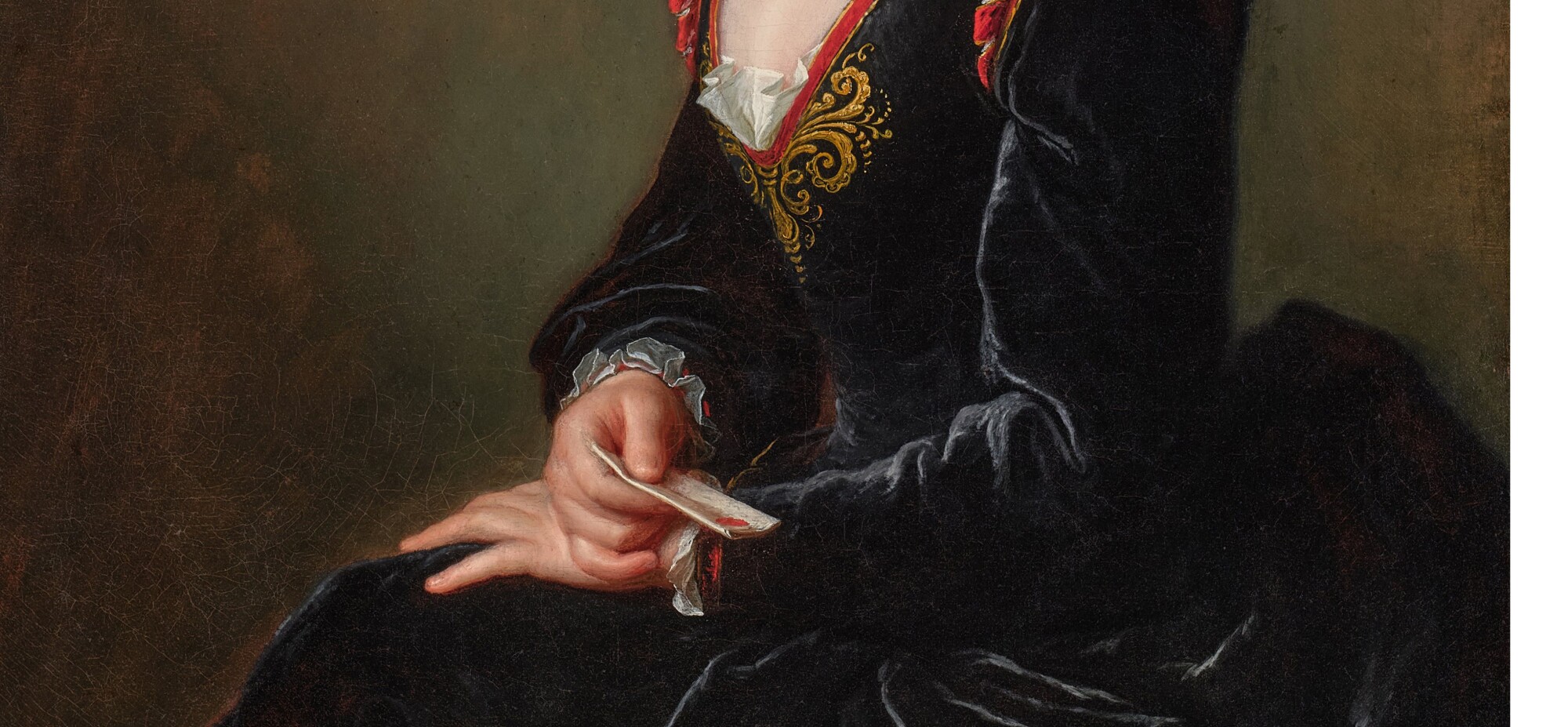J
ean-Baptiste Santerre executed this alluring depiction of a young woman dressed “à la espagnole” during the first decade of the eighteenth century. Combining aspects of portraiture and genre painting, Santerre’s image is at once personal and full of romantic whimsy. Baraton, in his Poésies diverses, encapsulated the graceful charm that defined the artist’s aesthetic: “With a marvelous brush, Santerre adds new loveliness to nature’s beauty, And all hearts are enchanted by the grace of his paintings.”1
The refined sitter, appearing lost in reverie, demurely averts her gaze from the viewer. A prominent lace ruff2 draws attention to her softly-lit oval face, which is framed by her powdered hair and accentuated by a black beret with striking blue plumes. The luxurious black velvet gown with crimson shoulder rolls and gold embroidery speaks to the vogue for “espagnolette”3 attire in the first decade of the eighteenth century, when both actresses at the Comédie Française and guests at masked balls wore such dresses.4 The sitter’s past identification as Charlotte Desmares (1782-1752), a celebrated stage actress and mistress of Philippe II, duke of Orléans, likely reflects this intersection of fashionable trends.

Among Santerre’s most popular works, the composition was reproduced in numerous painted copies.5 Additionally, Nicolas Chateau engraved the figure in 1708 (thus providing a terminus ante quem for the canvas’s execution) and the Gobelins manufactory produced a woven adaptation in 1726.6 A quatrain underscoring the image’s beguiling character accompanied Chateau’s widely-circulated print:
Behold, my features are of beauty divine, My eyes dark and brilliant, my complexion vivid and charming, But my mind is of a fabric so fine, That I only give it to the most subtle lover. 7
The shroud of amorous mystery to which the poem alludes is underscored by the inclusion of a sealed letter.8 Adopted from seventeenth-century genre paintings that focused on epistolary exchange,9 the motif firmly situates the image in the sentimental realm of the everyday, where glances are stolen, secrets confessed, and hearts made to flutter.
1 “D’un pinceau merveilleux, à la belle nature, / Santerre ajoute encore de Nouvelles beautez; / Et tous les cœurs sont enchantez / Par les grâces de sa peinture.” Quoted in Potiquet 1876, p. 6.
2 Santerre painted the white collar over the woman’s dress, suggesting that he added this component of the sitter’s costume late in the work’s production. As such, and coupled with the refined execution, the work is almost certainly the composition’s prime. See Cordier 2023, p. 105.
3 On Santerre’s treatment of this theme, see C. Lesné and F. Waro, Jean Baptiste Santerre, 1651-1717, Magny-en-Vexin 2011, pp. 79-81.
4 In Santerre’s 1707 portrait of Madame Pelletier des Forts, the sitter is similarly attired, but she holds a black mask, rather than a sealed letter, in her right hand.
5 See, for example, versions at Boston’s Museum of Fine Arts, inv. no. 47.245, and Paris’s Comédie-Française, inv. no. I 0204.
6 With Jacques Seligmann and Co., New York and Paris, 1933, according to whom the signed cartoon (measuring 38 ½ by 35 ½ in.) was in the collection of the Duke de Marmier. See “A Tapestry Portrait of Great Rarity: Fine Painting by Weaving,” in Illustrated London News (8 April 1933), p. 490.
7 “A me voir j’ai les traits d’une beauté divine, / Les yeux noirs et brillants un teint vif et charmant, / Mais j’ai l’esprit formé d’une étoffe si fine, / Que j’en donne à garder au plus subtil amant.” See for instance, the impression in London’s British Museum, inv. no. 1917,1208.2069.
8 The work has previously been called “Jeune fille au billet doux” (Young Girl with a Love Letter).
9 As a favorite protégé of King Louis XIV, Santerre received a pension and lodgings in the Louvre Palace, where he would have had easy access to study (and on occasion copy) such works.